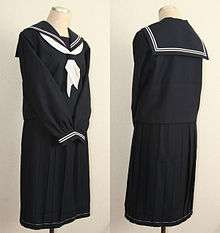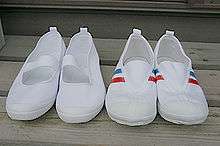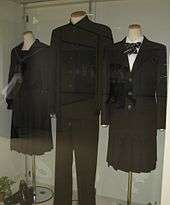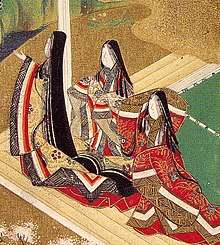School uniforms in Japan
The Japanese school uniform is modeled in appearance similar to that of the European-style naval uniforms and was first used in Japan in the late 19th century, replacing the traditional kimono.[1] Today, school uniforms are common in many of the Japanese public and private school systems. The Japanese word for this type of uniform is seifuku (制服).

History
The majority of Japan’s junior high and high schools require students to wear uniforms. The Japanese school uniform is not only a symbol of youth but also plays an important role in the country’s culture. There are many types of uniforms that range from standard to unique ones varying in the ensembles used. Japanese school uniforms have been around for 150 years. Its first model was similar to the appearance of European-style naval uniforms. It is called “seifuku” in Japanese and was first used in the 19th century. The idea was taken from scaled-down sailor suits worn by children coming from royal European families. It was relatively easy to sew and thus was easily adopted in the country. Talking about junior and senior high school uniforms, the traditional attire was taken from the Meiji era consisting of military-style uniform for boys and sailor outfit for girls. After which, many schools adopted a more Western-pattern Catholic uniform style. Girls started wearing white blouses with ties, blazers with their school crests, and skirts. Boys also wore white shirts with ties, blazers, and tailored trousers. Schools in Japan do not have gender-exclusive locker rooms; thus, it is quite difficult to change from classroom uniforms into sports uniforms. As a result, most students wear their sports uniforms under their classroom uniforms. Some schools are very particular with the hairstyles as well as the footwear, too. Traditionally, school uniforms were worn outside of school, but these days, students change into casual clothing upon going out of school.
The gakuran and sailor-style dress have always been a part of Japan's "growing modern" culture due to its formal appearance and its existence as a concept. Old-fashioned textbooks state that the uniforms were based on the Imperial Japanese Army uniform rather than the European uniforms. The sides of the uniform are similar to existing styles of Japanese dressmaking and the collar had straight lines. Many home economics classes in Japan up until the 1950s gave sewing sailor outfits as assignments. Girls sewed sailor outfits for younger children in their communities. In the 1980s, sukeban gangs began modifying uniforms by making skirts longer and shortening the tops, and so schools began switching to blazer or sweater vest style uniforms to try to combat the effect. As of 2012, 50% of Japanese junior high schools and 20% of senior high schools use sailor suit uniforms.The Asahi Shimbun stated in 2012 that, "The sailor suit is changing from adorable and cute, a look that 'appeals to the boys,' to a uniform that 'girls like to wear for themselves.'" As of that year, contemporary sailor suits have front closures with zippers or snaps and more constructed bodices. The Asahi Shimbun stated that "[t]he form is snug to enhance the figure—the small collar helps the head look smaller, for better balance."
Usage

The Japanese junior and senior-high-school uniform traditionally consists of a military-styled uniform for boys and a sailor outfit for girls. These uniforms are based on Meiji era formal military dress, themselves modeled on European-style naval uniforms. The sailor outfits replace the undivided hakama (andon bakama 行灯袴) designed by Utako Shimoda between 1920 and 1930.[2] While this style of uniform is still in use, many schools have moved to more Western-pattern catholic school uniform styles. These uniforms consist of a white shirt, tie, blazer with school crest, and tailored trousers (often not of the same color as the blazer) for boys and a white blouse, tie, blazer with school crest, and tartan culottes or skirt for girls.
Regardless of what type of uniform any particular school assigns its students, all schools have a summer version of the uniform (usually consisting of just a white dress shirt and the uniform slacks for boys and a reduced-weight traditional uniform or blouse and tartan skirt with tie for girls) and a sports-activity uniform (a polyester track suit for year-round use and a T-shirt and short pants for summer activities). Depending on the discipline level of any particular school, students may often wear different seasonal and activity uniforms within the same classroom during the day. Individual students may attempt to subvert the system of uniforms by wearing their uniforms incorrectly or by adding prohibited elements such as large loose socks or badges. Girls may shorten their skirts, permanently or by wrapping up the top to decrease length; boys may wear trousers about the hips, omit ties, or keep their shirts unbuttoned.
Since some schools do not have sex-segregated changing- or locker-rooms, students may change for sporting activities in their classrooms. As a result, such students may wear their sports uniforms under their classroom uniforms. Certain schools also regulate student hairstyles, footwear, and book bags; but these particular rules are usually adhered to only on special occasions, such as trimester opening and closing ceremonies and school photo days.
It is normal for uniforms to be worn outside of school areas, however this is going out of fashion and many students wear a casual dress.[3] While not many public elementary schools in Japan require uniforms, many private schools and public schools run by the central government still do so.
Gakuran

The gakuran (学ラン) and the tsume-eri (詰襟) are the uniforms for many middle-school and high-school boys in Japan. The color is normally black, but some schools use navy blue.
The top has a standing collar buttoning down from top-to-bottom. Buttons are usually decorated with the school emblem to show respect to the school. Pants are straight leg and a black or dark-colored belt is worn with them. Boys usually wear penny loafers or sneakers with this uniform. Some schools may require the students to wear collar-pins representing the school and/or class rank.
Traditionally, the gakuran is also worn along with a matching (usually black) student cap, although this custom is less common in modern times.
The gakuran is derived from the Prussian Waffenrock. The term is a combination of gaku (学) meaning "study" or "student", and ran (らん or 蘭) meaning the Netherlands or, historically in Japan, the West in general; thus, gakuran translates as "Western style clothes for student (uniform)".The original model of the present days Gakuran was first established in 1886 for the students of Tokyo University. During the Japanese occupation, Such clothing was also brought to school in South Korea and pre-1949 China.
Sailor fuku

The sailor fuku (セーラー服, sērā fuku, Sailor outfits) is a common style of uniform worn by female middle school students, traditionally by high school students, and occasionally, elementary school students. It was introduced as a school uniform in 1920 in Heian Jogakuin (平安女学院)[4] and 1921 by the principal of Fukuoka Jo Gakuin University (福岡女学院),[5] Elizabeth Lee. It was modeled after the uniform used by the British Royal Navy at the time, which Lee had experienced as an exchange student in the United Kingdom.
Much like the male uniform, the gakuran, the sailor outfits bears a similarity to various military styled naval uniforms. The uniform generally consists of a blouse attached with a sailor-style collar and a pleated skirt. There are seasonal variations for summer and winter: sleeve length and fabric are adjusted accordingly. A ribbon is tied in the front and laced through a loop attached to the blouse. Several variations on the ribbon include neckties, bolo ties, neckerchiefs, and bows. Common colors are navy blue, white, grey, light green and black.
Shoes, socks, and other accessories are sometimes included as part of the uniform. These socks are typically navy or white. The shoes are typically brown or black penny loafers. Although not part of the prescribed uniform, alternate forms of legwear (such as loose socks, knee-length stockings, or similar) are also commonly matched by more fashionable girls with their sailor outfits.
The sailor uniform today is generally associated solely with junior high schools, since a majority of high schools have changed to more Western-style plaid skirts or blazers.
LGBT considerations
The attire is gender-specific and the two options, male or female, are dispensed to students according to the sex they were assigned at birth. "The idea behind the uniform is that if you can’t wear it properly, you're a bad student," said Mameta Endo, a trans male LGBT activist from Tokyo.[6] "It makes you an outcast."[6] In 2015, Japan's Ministry of Education issued a directive that suggested teachers should "accept students' preference of outfit, school and gym uniform."[6] Implementation has been piecemeal but appears to be gaining traction in some schools, sparking discussions in local school boards and governments. The education ministry followed its 2015 directive with a "guidebook" for teachers in 2016.[6]
That same year, Japan, along with the United States and the Netherlands, led a UNESCO conference about homophobic bullying in schools,[6] and in March 2017, the ministry announced it had revised the national bullying prevention policy to include LGBT students.[6] School officials hope the move will ease the mental anguish of such students,[7] who are usually required to wear gender-based uniforms typified by jackets with stand-up collars and trousers for boys, and sailor-type outfits with skirts for girls. At Kashiwanoha Junior High School, which opened in Kashiwa, Chiba Prefecture in April, students can freely choose whether to wear skirts or slacks or ties or ribbons with blazers, regardless of their sex. Originally, the school did not intend to make students wear a uniform, but had to change course because nearly 90% of parents and prospective students surveyed wanted one. A panel of parents, teachers, prospective students, and education board members was set up to discuss the uniform designs. Some said consideration should be paid to LGBT students and that girls should also be allowed to wear trousers because they are more practical and warmer in winter.
Cultural significance
.jpg)
Various schools are known for their particular uniforms. Uniforms can have a nostalgic characteristic for former students, and are often associated with relatively carefree youth. Uniforms are sometimes modified by students as a means of exhibiting individualism, including lengthening or shortening the skirt, removing the ribbon, hiding patches or badges under the collar, etc. In past decades, brightly coloured variants of the sailor outfits were also adopted by Japanese yankii, sukeban and Bōsōzoku biker gangs.[8]
See also
References
- Katarina Kottonen (2017-08-25). "Seifuku". Chance and Physics.
- 制服でたどる百年
- "Uniforms - The Japanese Fashion Everyone Loves" (April 2011). Hiragana Times, Volume 294, pp. 12–15.
- 女子生徒に洋装制服登場、大正モダン Archived 2009-06-09 at the Wayback Machine
- 平安女学院(京都)と福岡女学院(福岡)の間で、セーラー服の起源を巡る論争が勃発!
- Admin (June 20, 2018). "Japan's School Uniform Shift Will Help LGBT Students". lgbtlife.co.uk. LGBT Life. Retrieved July 1, 2019.
- Tan, Kiki (October 16, 2014). "Mameta Endo: Confronting wrongdoings against LGBTs". Outrage. Retrieved July 1, 2019.
Particularly in Japan, 'bullying and suicide among young people is a very serious problem. Most teachers, parents and lawmakers want to decrease bullying and suicide among teens. So the LGBT community needs to speak out and tell them about who we really are, and what is going on among LGBT teens. I think we can help each other to make it better,' Mameta said.
- Grigsby, Mary (1998). "Sailormoon: Manga (Comics) and Anime (Cartoon) Superheroine Meets Barbie: Global Entertainment Commodity Comes to the United States". The Journal of Popular Culture 32(1):59–80. doi:10.1111/j.0022-3840.1998.3201_59.x.
External links
| Wikimedia Commons has media related to Japanese school uniform. |
- School Uniform: Japan at Boys' Historical Clothing
